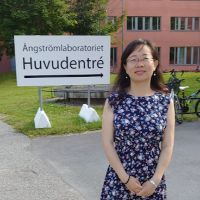Materials for Applications in Water Splitting and Battery
A special issue of Crystals (ISSN 2073-4352). This special issue belongs to the section "Materials for Energy Applications".
Deadline for manuscript submissions: 1 August 2024 | Viewed by 179
Special Issue Editor
Interests: computational materials physics; hydrogen storage; hybrid perovskites; solar cell; catalysis; battery
Special Issue Information
Dear Colleagues,
The field of photoelectrochemical water splitting offers a compelling and sustainable avenue for generating hydrogen fuel—a versatile and clean energy resource with applications ranging from transportation to electricity generation and industrial processes. Ongoing research in this field is advancing rapidly, holding the potential to significantly enhance our pursuit of a sustainable and eco-friendly energy landscape.
Driven by the quest for heightened photocatalytic efficiency, researchers are delving into the exploration and design of novel photocatalyst materials. Their focus lies in bolstering key properties like light absorption, charge separation, and surface area. This exploration encompasses a diverse range of materials, including transition metal oxides, 2D materials, metal–organic frameworks (MOFs), covalent organic frameworks (COFs), and various composite structures. In tandem, scientists are intensively unraveling the kinetics and mechanisms underpinning photocatalytic water splitting. Employing advanced computational modeling and characterization techniques, they are currently dissecting complex reaction pathways and identifying pivotal intermediates and surface species. While encouraging results have emerged from lab-scale experiments, the challenge of upscaling photocatalytic water-splitting technologies remains. Consequently, researchers are actively devising engineering solutions for large-scale implementation and seamless integration with renewable energy systems.
Concurrently, the field of batteries, as a pivotal energy storage solution, is witnessing transformative progress through first-principles calculations. This potent approach delves into atomic and molecular levels to comprehend the fundamental physical and chemical processes. Electrode materials, a critical battery component, have especially benefitted from this method. They allow for a systematic exploration of material composition, crystal structures, and electronic properties, thus identifying optimal candidates for high-capacity and durable battery electrodes. Moreover, intricate electrode–electrolyte interfaces, governing charge transfer, ion diffusion, and surface reactions, have been meticulously investigated. These insights contribute significantly to battery performance optimization. First-principles calculations have also facilitated the discovery of novel materials tailored for specific properties, propelling advancements in high-energy and high-power electrode materials. Furthermore, understanding battery degradation mechanisms through defect simulations, phase transitions, and structural stability analyses has led to strategies for extending battery lifespan.
The application of first-principles calculations in battery research has unveiled fundamental electrochemical insights, predicting reaction kinetics, thermodynamics, and transport properties. This optimization potential spans electrode–electrolyte interfaces, ultimately enhancing battery efficiency and overall performance.
In light of these captivating advancements, we are pleased to invite you to contribute to our Special Issue on "Materials for Energy Applications in Water Splitting and Battery." This exclusive collection aims to showcase high-quality research elucidating material design and property mechanisms for photochemical water splitting, electrochemical processes, as well as optimization of electrode–electrolyte interfaces. As Guest Editor, please feel free to reach out to me at xiaoyong.yang@physics.uu.se for inquiries or to express any interest in participating. We eagerly anticipate your invaluable contributions, aspiring to present a comprehensive compilation of the leading research within this exciting domain.
Dr. Xiaoyong Yang
Guest Editor
Manuscript Submission Information
Manuscripts should be submitted online at www.mdpi.com by registering and logging in to this website. Once you are registered, click here to go to the submission form. Manuscripts can be submitted until the deadline. All submissions that pass pre-check are peer-reviewed. Accepted papers will be published continuously in the journal (as soon as accepted) and will be listed together on the special issue website. Research articles, review articles as well as short communications are invited. For planned papers, a title and short abstract (about 100 words) can be sent to the Editorial Office for announcement on this website.
Submitted manuscripts should not have been published previously, nor be under consideration for publication elsewhere (except conference proceedings papers). All manuscripts are thoroughly refereed through a single-blind peer-review process. A guide for authors and other relevant information for submission of manuscripts is available on the Instructions for Authors page. Crystals is an international peer-reviewed open access monthly journal published by MDPI.
Please visit the Instructions for Authors page before submitting a manuscript. The Article Processing Charge (APC) for publication in this open access journal is 2600 CHF (Swiss Francs). Submitted papers should be well formatted and use good English. Authors may use MDPI's English editing service prior to publication or during author revisions.
Keywords
- low-dimensional materials
- nanocrystals, nanocage
- sustainable materials
- emerging functional nanomaterials
- heterostructures
- energy storage and conversion
- battery research
- electrode–electrolyte interfaces
- high-energy electrode materials
- material design
- photoelectrochemical water splitting





